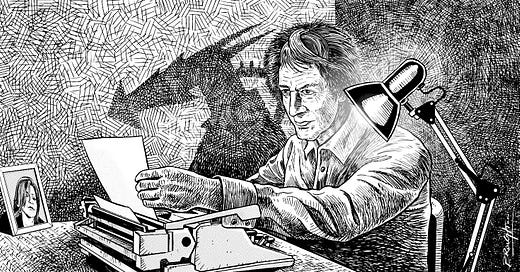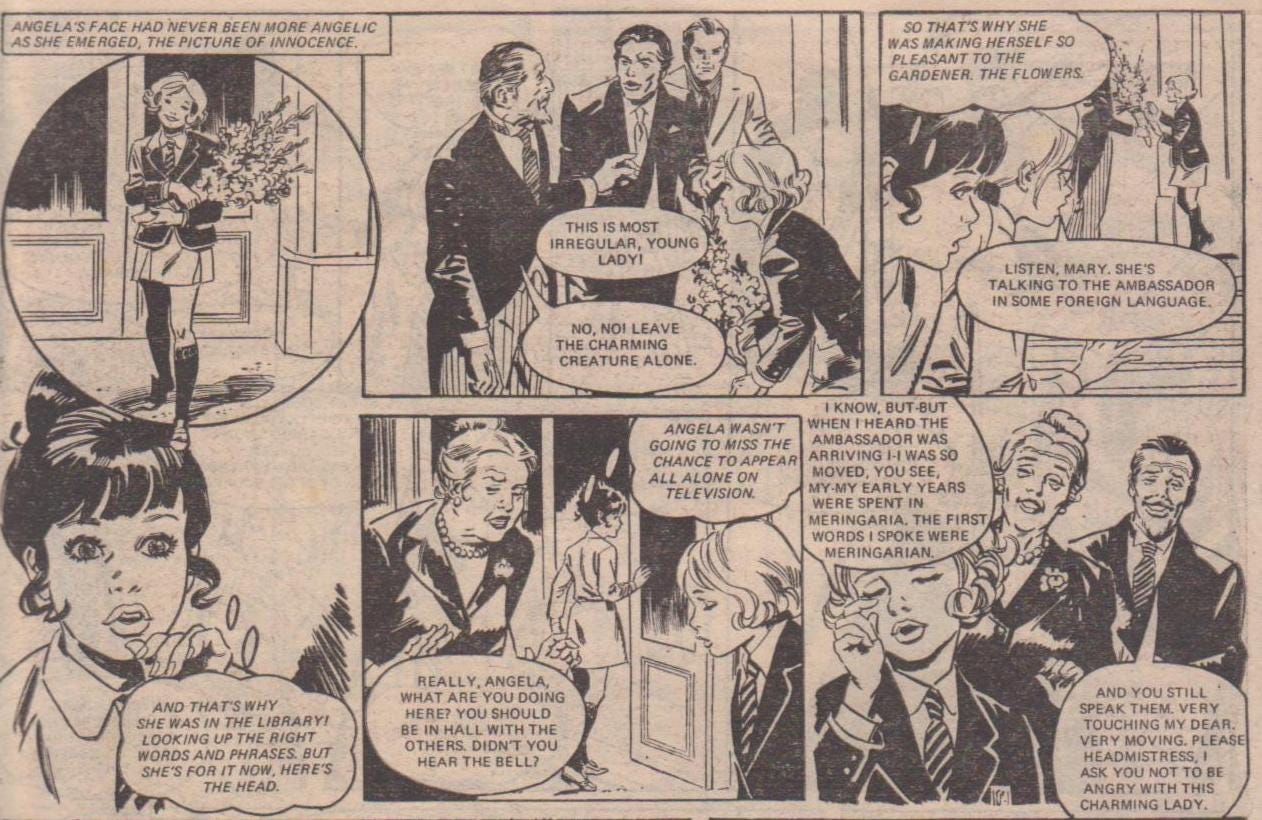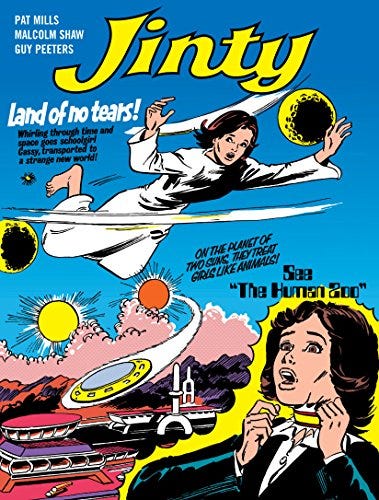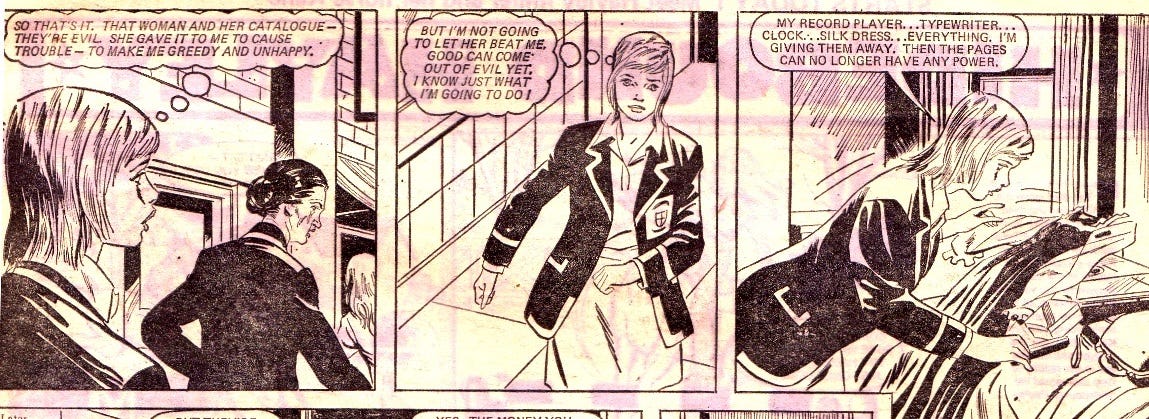Pageturners: Girls comics Part 2
Anti-heroine stories were not about rivalry as such, but more about jealousy and, invariably, they had a bitter tone to them.
Welcome to Pageturners, a book I’m writing in which I share what I’ve learnt – and am still learning – about comic writing, film writing, novel writing and how new writers can sell their stories. I’ll publish a chapter or a section per week, available for free here on Iconoblast. And I welcome your feedback or questions, so do leave a comment below!
Missed the Pageturners intro? Read it here.
If you missed it, catch up on Girls Comics Part 1.
ANTI-HEROINE STORY
Often we took the standard Cinderella story and turned it on its head. That worked as well as the original. Thus there was Cinderella Spiteful, where the title speaks for itself. Angela Angel Face who, despite her sweet appearance, is a brat. And Ella on Easy Street, who doesn’t want her family to succeed and tries to sabotage their efforts to get on. That sounds a bit negative, but it was actually brilliantly written by radio writer Charles Herring, drawn by Casanovas, and it was a big hit with the readers, who enjoyed its subversive nature.
Girls who were smug, talented and pretty were often the focus of such stories, with the somewhat plain or ordinary heroine constantly being overshadowed by them and trying to succeed despite their brilliant, beautiful and talented cousin, friend or sister. These stories were not about rivalry as such, but more about jealousy and, invariably, they had a bitter tone to them. They were so successful I tried a male equivalent in Action: Green’s Grudge War, written by Gerry Finley-Day and drawn by Bellardinelli. It followed the same story principles and was well written and drawn. Alas, it bombed. Male readers, I discovered, weren’t interested in reading about jealousy, anymore than they were interested in mysteries. I should have stuck to Top Gun-style stories! But a female audience thrived on it.
I’d love to know if things have changed over the decades: are there any successful boys’ stories covering jealousy? Drop me a comment below if you know of any.
VILLAIN STORY
This is a difficult sub-genre to get right. Thus Tammy ran a powerful, well-written Victorian serial entitled My Father, My Enemy. It didn’t work because the readers were uncomfortable with dad being the enemy. Generally speaking, we found mum and dad were off-limits as villains and I suspect the same would still be true today, even with changes in society. Now if it had been My Stepfather, My Enemy…
Gerry Finley-Day also came up with a brilliant idea for a rather different villain: ‘Aunt Aggie’. She is a salt of the earth, heart of gold, TV personality, who does endless good work for charity. Loved by millions, but in reality she is a cruel, cold, heartless, conniving bitch. Kind of like Jimmy Savile… Gerry gave it to me to write and I’m afraid I completely ballsed it up. I was too young and inexperienced to get it right. I’ve always regretted it, because Aunt Aggie had so much potential. And of course, it’s a remarkably subversive story – if anything, more relevant for today than when I originally wrote it.
EXPLOITATION STORY
Exploitation serials or ‘slave serials’, as we called them in those politically incorrect times, were mandatory because of their incredible popularity. Judy even had a serial called Wee Slavey. Yes, really. And in Tammy there was Slaves of the Hot Stove.
Some of them were incredibly savage and would make us wince today. The most savage and powerful of all was Slaves of War Orphan Farm in Tammy – featuring the brutal Ma Thatcher (actually named after Mrs Thatcher), which is highly regarded by readers today. By comparison, my own Captives of Madam Karma in Sandie was nowhere near as memorable. Then there was Camp on Candy Island, written by Tammy editor Gerry Finley-Day, about a strange and nightmare holiday camp, inspired by The Prisoner. It ran for months and months so I’m pretty certain it was a hit. The Hunger Games shows that this genre still has legs today.
SCIENCE FICTION STORY
My Land of No Tears and Malcolm Shaw’s The Human Zoo, now published by Rebellion, are good examples of female-orientated science fiction. I read them both when they were reprinted and was impressed by their pacing and powerful emotions. Once again, The Hunger Games shows they could work today. There’s also Malcolm’s fantastic The Sentinels in Misty, about an alternative Nazi-occupied Britain.
MYSTERY STORY
Mystery stories with a hard modern edge always went down well. So if I was writing such a story today it might well focus on something spooky happening to a mobile phone, a tablet, or on the web. Back in the day, I wrote Glenda’s Glossy Pages, drawn by Mario Capaldi, about a strange mail order catalogue which Glenda happens across. Everything that desperately poor Glenda desires from it – clothes, a bike, games, arrives on her doorstep even though she has no money. They’re all free! Of course, ultimately there is a price to be paid…
My three young, very politically correct and cool nieces liked the story but not the heroine, because, they told me, she wasn’t pretty enough. And they didn’t like what she was wearing. I’m glad they said that, because I thought it, but didn’t dare say it. The Sentinels (see above) was also by Capaldi. I’m fairly certain that if a different artist – Casanovas, for example – had drawn the story and made the heroine prettier it would have been an even bigger hit. I know fans of The Sentinels liked the way Capaldi drew, but the majority view has to be considered, too.
That brings me onto the subject of the art and a brief but important digression. Sensitive as that subject might be for modern pc adult audiences, the art and the way the heroine looks and what she wears was – and still is – an important factor which editors ignore at their peril!
Thus artist Fay Dalton draws incredibly beautiful young women and I’m absolutely convinced the reason she never got into 2000AD was because they were too sexy/beautiful for someone’s politically correct taste there. They’ll deny it, of course, but I can think of no other reason why, because her work is superb and very popular. She’s now doing fantastic prestigious illustration work on James Bond.
DISABILITY STORY
Disability stories would have to be handled with considerably more care and sensitivity than they were in the past. They would have to be well researched and aware of the latest terminology. But all that makes them even more interesting to produce.
Past disability stories had few constraints and they were usually very popular because a protagonist overcoming life’s challenges will always appeal to a big audience.
Blind Ballerinas were so successful, they ultimately led to ridiculous stories like the blind tennis player: Becky Never Saw the Ball. (Not written by me, I hasten to add.) Others could be even more tasteless. Limp Along Lindy in Bunty, for instance. Despite its crass title it was actually well written and drawn, although seriously over the top. Also in Bunty was Flipper Feet, about a girl with big feet who is a great swimmer. The principle of overcoming adversity is sound, it’s the rendering of it in these examples which makes us feel uncomfortable today.









